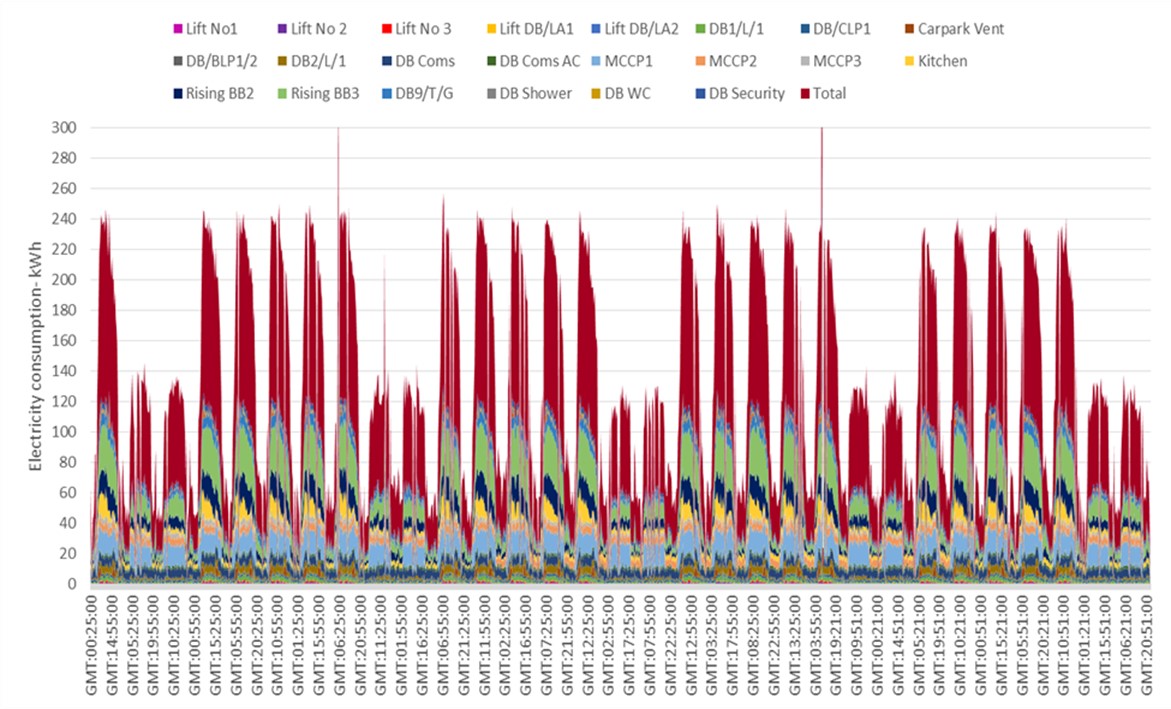Regulated and unregulated energy consumption

|
Contents |
[edit] Introduction
A building’s energy consumption varies considerably according to the building’s function. Its total operational energy usage comprises regulated and unregulated energy. BREEAM broadly defines regulated and unregulated energy consumption as follows:
[edit] Regulated energy
‘Regulated energy is building energy consumption resulting from the specification of controlled, fixed building services and fittings, including space heating and cooling, hot water, ventilation, fans, pumps and lighting. Such energy uses are inherent in the design of a building.’
Designers may not be able to predict how the services and fittings will be used but they can design them to be as energy efficient as possible.
NB The Home Quality Mark One, Technical Manual SD239, England, Scotland & Wales, published by BRE in 2018 defines a regulated energy as; ‘…building energy consumption resulting from the specification of controlled, fixed building services and fittings, including space heating and cooling, hot water, ventilation and lighting.’
[edit] Unregulated energy
Unregulated energy is building energy consumption resulting from a system or process that is not ‘controlled’, ie energy consumption from systems in the building on which the Building Regulations do not impose a requirement. For example, this may include energy consumption from systems integral to the building and its operation, e.g. IT equipment, lifts, escalators, refrigeration systems, external lighting, ducted-fume cupboards, servers, printers, photocopiers, laptops, cooking, audio-visual equipment and other appliances.
Some buildings can have unregulated energy accounting for 50% of total energy use.
Unlike regulated energy use, unregulated energy consumption is usually only determined very late in the design process; it can also vary throughout the building lifecycle. This is because buildings may have different occupants or uses.
NB The Home Quality Mark One, Technical Manual SD239, England, Scotland & Wales, published by BRE in 2018 defines a unregulated energy as; ‘…the energy consumption of the home that is not ‘controlled’, i.e. energy consumption from aspects of the home on which Building Regulations do not impose a requirement. For the purposes of the HQM assessment, this includes energy associated with lighting, appliances and cooking.’
[edit] Building regulations
Designers usually demonstrate compliance with Approved Document L of the building regulations as evidence of a building’s energy efficiency. But this does not fully reflect reality, as regulated energy is only a part of the total. Although they can usually predict regulated energy usage, it becomes more difficult with unregulated energy as predicting user behaviour can be problematic. This means that designers should not be held accountable for total operational energy usage as it is something they can only partly influence.
[edit] Related articles on Designing Buildings Wiki
- Approved document L.
- BREEAM.
- Building Regulations.
- Energy performance certificates.
- Leadership in Energy and Environmental Design (LEED).
- New energy retrofit concept: ‘renovation trains’ for mass housing.
- Operational carbon.
- Performance gap.
- The code for sustainable homes.
[edit] External references
- Bonfield review.
- Energy Saving Trust.
- EU Energy Efficiency Directive.
- Part L (Conservation of fuel and power).
- Planning Portal – Energy Saving.
Featured articles and news
Latest Build UK Building Safety Regime explainer published
Key elements in one short, now updated document.
UKGBC launch the UK Climate Resilience Roadmap
First guidance of its kind on direct climate impacts for the built environment and how it can adapt.
CLC Health, Safety and Wellbeing Strategy 2025
Launched by the Minister for Industry to look at fatalities on site, improving mental health and other issues.
One of the most impressive Victorian architects. Book review.
Common Assessment Standard now with building safety
New CAS update now includes mandatory building safety questions.
RTPI leader to become new CIOB Chief Executive Officer
Dr Victoria Hills MRTPI, FICE to take over after Caroline Gumble’s departure.
Social and affordable housing, a long term plan for delivery
The “Delivering a Decade of Renewal for Social and Affordable Housing” strategy sets out future path.
A change to adoptive architecture
Effects of global weather warming on architectural detailing, material choice and human interaction.
The proposed publicly owned and backed subsidiary of Homes England, to facilitate new homes.
How big is the problem and what can we do to mitigate the effects?
Overheating guidance and tools for building designers
A number of cool guides to help with the heat.
The UK's Modern Industrial Strategy: A 10 year plan
Previous consultation criticism, current key elements and general support with some persisting reservations.
Building Safety Regulator reforms
New roles, new staff and a new fast track service pave the way for a single construction regulator.
Architectural Technologist CPDs and Communications
CIAT CPD… and how you can do it!
Cooling centres and cool spaces
Managing extreme heat in cities by directing the public to places for heat stress relief and water sources.
Winter gardens: A brief history and warm variations
Extending the season with glass in different forms and terms.
Restoring Great Yarmouth's Winter Gardens
Transforming one of the least sustainable constructions imaginable.






















